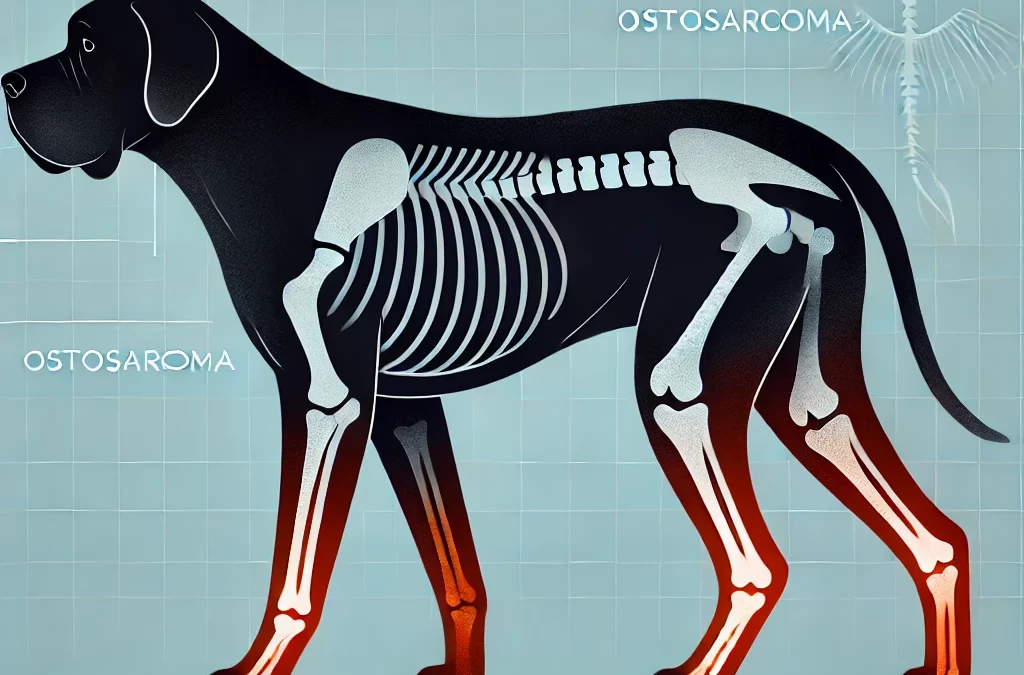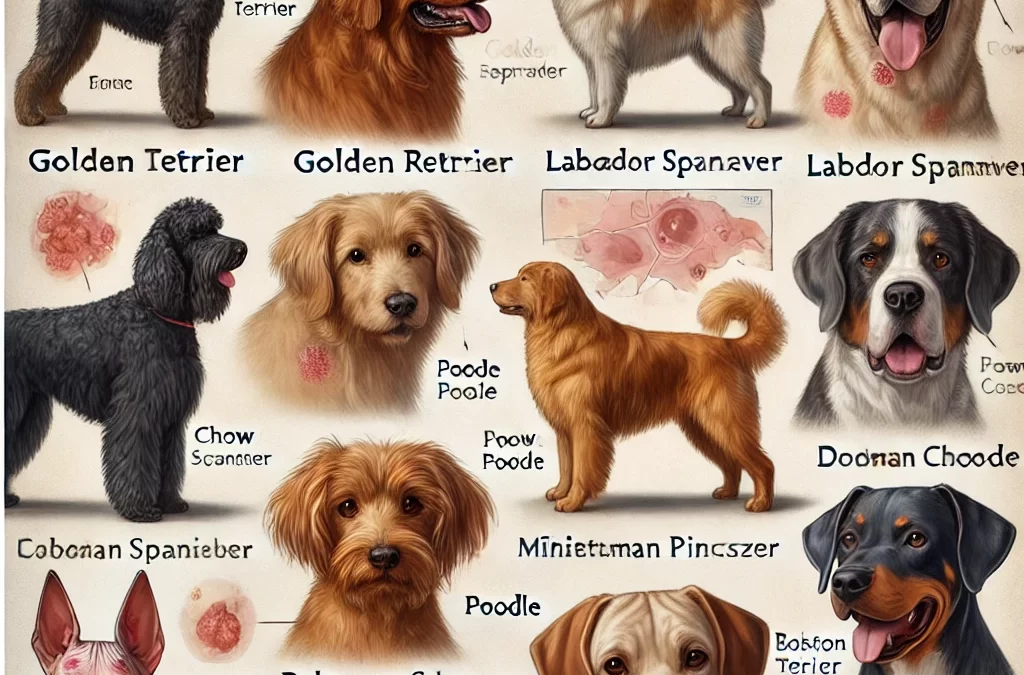
執筆者 TCMVET | 2025年2月6日 | 犬の癌と腫瘍
がんはペットの飼い主、特に複数の犬を飼っている飼い主にとって大きな懸念事項となっています。家庭内の犬ががんと診断されると、次のような疑問が湧きます。 犬の癌は伝染しますか? がんの性質とその広がり方を理解することで、ペットの飼い主は適切な予防策を講じながら、愛犬に最善のケアを提供できるようになります。
犬の癌は伝染しますか?
簡単な答えは いいえ—犬の癌のほとんどは 伝染しないウイルスや細菌によって引き起こされる感染症とは異なり、がんは個体の体内で異常な細胞が制御不能に増殖する病気です。直接接触したり、食器を共有したり、近づいたりすることで犬から犬に感染することはありません。
しかし、 まれな例外、 のような 伝染性性器腫瘍(TVT)、特に交配中に直接接触することで広がる可能性があります。TVT は犬で自然に発生する数少ない伝染性の癌の 1 つであり、主に野良犬や去勢されていない犬に影響します。これとは別に、リンパ腫、骨肉腫、肥満細胞腫などの従来の癌は犬間で伝染しません。
がんは環境要因の影響を受けるのでしょうか?
がん自体は伝染性はないが、同じ家庭で暮らす犬同士で感染する可能性がある。 一般的な環境リスク がんの発生に寄与する可能性のあるものには、次のようなものがあります。
- 受動喫煙 – 喫煙している家庭で飼われている犬は、肺がんや鼻の腫瘍を発症するリスクが高くなります。
- 有毒化学物質 – 殺虫剤、除草剤、家庭用洗剤はペットのがんリスクを高める可能性があります。
- 食事と肥満 – 不健康な食生活と肥満による炎症は、時間の経過とともにがんの発症につながる可能性があります。
- Genetics – 家庭内の複数の犬が同じ血統または品種である場合、特定の癌に対する遺伝的素因を持っている可能性があります。
複数の犬を飼っている飼い主は何をすべきでしょうか?
がんは伝染性ではありませんが、ペットの飼い主はすべての犬の健康と幸福を確保するために、特定の予防措置を講じる必要があります。
1. 健全な環境を維持する
- タバコの煙や刺激の強い化学物質など、有害な毒素を家から排除しましょう。
- 犬が遊ぶ場所では殺虫剤や除草剤の使用を避けてください。
2. 栄養のある食事をサポートする
- すべての犬に、新鮮で天然の食材を使用したバランスの取れた高品質の食事を与えてください。
- オメガ 3 脂肪酸や抗酸化物質など、免疫の健康をサポートするサプリメントを検討してください。
3. 他の犬の症状を監視する
- しこり、腫れ、体重減少、行動の変化がないか定期的に確認してください。
- 特に高齢犬や癌になりやすい犬種の場合は、毎年の獣医による健康診断と定期的な癌検診をスケジュールに入れましょう。
4. 感情的なサポートを提供する
- 1 匹の犬が癌と診断された場合、家庭内の他の犬もストレスや行動の変化を経験する可能性があります。
- 安定した生活習慣を維持し、家庭内のすべてのペットに快適さを提供します。
5. 獣医に相談する
- 自宅でのがんリスクが心配な場合は、予防と早期発見に関する個別のアドバイスについて獣医に相談してください。
結論
犬の癌は伝染しませんが、共通の環境要因と遺伝的素因が、家庭内の複数の犬の癌リスクに影響を与える可能性があります。健康的な家庭を維持し、適切な栄養を与え、症状に注意することで、飼い主は犬がより長く、より健康な生活を送ることができるようにすることができます。犬の 1 匹が癌と診断された場合、愛情と慰め、適切な医療を提供することが、犬をサポートしながら、家族全体の健康を確保する最善の方法です。

執筆者 TCMVET | 2025年1月26日 | 犬の癌と腫瘍
骨肉腫 (OSA) は、犬に最も多く見られる原発性骨癌で、大型犬や超大型犬に特に多く見られます。この癌は攻撃的な性質と急速な転移により、ペットの飼い主にとって大きな課題となります。しかし、リスク要因を理解し、予防策を講じることで、状況は変わります。この記事では、大型犬が骨肉腫にかかりやすい理由と、リスクを最小限に抑えるために飼い主が講じることができる予防策について説明します。
大型犬や超大型犬はなぜ骨肉腫にかかりやすいのでしょうか?
- 急速な成長と骨の発達
大型犬や超大型犬は生後数か月で急速に成長し、骨に負担がかかります。この急速な成長により骨の構造に微細な損傷が生じ、がん性変異を起こしやすくなります。
- 遺伝的要因
特定の犬種は骨肉腫になりやすい遺伝的素因を持っています。一般的に影響を受ける犬種は次のとおりです。- グレートデーン
- セントバーナード
- アイリッシュウルフハウンド
- ロットワイラー
- グレイハウンド
- ラブラドール・レトリバー
- ゴールデンレトリバー
- 四肢の長さと骨のストレス
背が高く手足が長い犬は骨に負担がかかりやすくなります。骨肉腫は、橈骨、尺骨、上腕骨、大腿骨などの体重を支える骨によく発生します。
- ホルモンの影響と避妊・去勢
研究によると、特に骨が成熟する前の早期の避妊手術や去勢手術は骨肉腫のリスクを高める可能性があるとされています。これは骨の成長調節に役割を果たす性ホルモンの除去と関係があると考えられています。
- 慢性炎症と骨外傷
度重なる外傷、過去の骨折、または整形外科手術は、特に骨肉腫にかかりやすい犬種では、犬の癌感受性を高める可能性があります。
大型犬の骨肉腫のリスクを減らす方法
- 子犬期の成長管理
- 成長中の骨に過度の負担をかける、高カロリーで成長を早める食事は避けてください。
- 大型犬の子犬には、安定した成長を促すよう特別に配合されたフードを与えてください。
- 抗酸化物質を含むバランスの取れた食事
- 豊富な食品を取り入れる オメガ3脂肪酸、ターメリック、抗酸化物質 炎症や酸化ストレスと戦うため。
- カルシウムとリンのレベルを管理した食事は、過剰な成長を起こさずに骨の健康をサポートします。
- 責任ある避妊去勢手術
- 犬の骨格が成熟するまで(大型犬では通常 18 ~ 24 か月)不妊手術を延期することを検討してください。
- がんリスクと生殖の健康のバランスをとるために、獣医師と代替不妊手術の選択肢について話し合ってください。
- 過度な負担をかけずに定期的に運動する
- 水泳や適度な散歩などの衝撃の少ない運動は、骨と関節の健康を維持するのに役立ちます。
- 特に若い犬の場合、過度のジャンプや繰り返しの高衝撃の活動は避けてください。
- 早期発見と定期検診
- 定期的な獣医検査は、微妙な骨の変化を早期に発見するのに役立ちます。
- 飼い主は次のような兆候に注意する必要があります。 足を引きずる、手足が腫れる、痛みが続く、突然動きにくくなる。
- 骨を強くするサプリメント
- グルコサミンとコンドロイチン: 関節と骨の健全性をサポートします。
- ビタミンDとK2: カルシウムの吸収と骨密度の向上に役立ちます。
- クルクミンと薬用キノコ: 抗炎症作用と潜在的な抗癌作用を示します。
- 環境毒素の回避
- 農薬、タバコの煙、人工添加物が入った加工ペットフードなど、既知の発がん物質への曝露を減らします。
最終的な考え
大型犬や超大型犬は骨肉腫のリスクが高いですが、予防ケアは、この脅威を軽減する上で重要な役割を果たします。バランスの取れた食事、運動量管理、責任ある飼育、定期的な健康状態のモニタリングは、ペットの飼い主がリスクを効果的に管理するのに役立ちます。積極的に行動することで、犬の寿命が延びるだけでなく、全体的な生活の質も向上します。足を引きずったり腫れたりしている兆候に気付いたら、獣医師に相談してください。早期診断は、結果を改善するために不可欠です。

執筆者 TCMVET | 2025年1月26日 | 犬の癌と腫瘍
メラノーマは犬のがんの中でも最も心配されるものの 1 つで、口、皮膚、爪床、さらには目にも現れることがあります。すべての犬がメラノーマを発症する可能性がありますが、特定の犬種は色素、皮膚の特徴、その他の生物学的要因により遺伝的にメラノーマになりやすい傾向があります。この記事では、メラノーマにかかりやすい犬種、環境要因の役割、ペットの飼い主が予防策を講じる方法について説明します。
なぜ一部の犬種は黒色腫になりやすいのでしょうか?
黒色腫は、犬の体内の色素生成細胞であるメラノサイトから発生します。特定の犬種では、以下の要因によりリスクが高まります。
- 遺伝的素因 – 一部の犬種は異常なメラノサイト増殖の可能性が高い遺伝性を持っています。
- 色素沈着と毛色 – 色素の濃い犬、特に毛が黒い犬種は、口腔内の黒色腫になりやすい傾向があります。逆に、色素の薄い犬は、日光にさらされる部分の皮膚の黒色腫になりやすい傾向があります。
- 環境要因 – 長時間の日光への曝露、免疫システムの機能、さらには食事も犬の黒色腫の発症に影響を与える可能性があります。
メラノーマのリスクが高い品種
研究と獣医の症例研究によると、以下の犬種は黒色腫を発症するリスクが高いことが示唆されています。
- スコティッシュテリア – 特に日光にさらされる部分では、皮膚の黒色腫につながることが多い。
- ゴールデンレトリバー – 特に口腔内に黒色腫を含むさまざまながんが発生しやすい。
- ラブラドール・レトリバー – 口腔内悪性黒色腫の症例の増加が報告されています。
- コッカースパニエル – 特に眼における黒色腫の発生率が高い(眼黒色腫)。
- チャウチャウ – 濃い色素により口腔内の黒色腫に対する感受性が高まります。
- プードル – ミニチュアプードルとスタンダードプードルは爪床悪性黒色腫と診断されています。
- ダックスフント – 遺伝的要因により皮膚黒色腫を発症する可能性が高くなります。
- ドーベルマン・ピンシャー – 口腔および爪床の黒色腫の発生率が高くなります。
- ミニチュアシュナウザー – 皮膚と口腔の両方に黒色腫ができやすい。
- ボストンテリア – 特に肌の色が薄い人では、皮膚の黒色腫のリスクが高まります。
リスクを高める環境要因とライフスタイル要因
たとえ犬が高リスクの品種でなかったとしても、外的要因が悪性黒色腫の発症に影響を与える可能性があります。
- 太陽に当たる – 皮膚の色が薄い犬や毛が薄い犬は、紫外線による皮膚悪性黒色腫を発症するリスクがあります。
- 口腔衛生 – 歯のケアが不十分だと炎症が起こりやすくなり、口腔内の悪性黒色腫のリスクが高まる可能性があります。
- 年齢 – 高齢の犬は、黒色腫につながる細胞変異を起こしやすくなります。
- 毒素と食事 – 犬の食事における化学物質への曝露と抗酸化物質の不足は、がん感受性に影響を与える可能性があります。
犬の飼い主のための予防策
- 定期的な獣医の診察 – 特にリスクの高い品種の場合、早期発見が重要です。
- 口腔および皮膚検査 – 犬の口の中、足、皮膚に異常な腫瘍がないか定期的にチェックしてください。
- 日焼け止め – 肌の色が薄い犬は過度の日光への露出を避ける必要があり、ペットに安全な日焼け止めが役立ちます。
- バランスの取れた食事 – 抗酸化物質とオメガ 3 脂肪酸は免疫機能をサポートし、炎症を軽減します。
- 口腔の健康を維持する – 犬の歯を磨き、デンタルガムを与えると口腔内の黒色腫のリスクが低下する可能性があります。
最終的な考え
黒色腫は悪性の癌ですが、犬種特有のリスクを認識し、積極的にケアすることで早期発見と予防に役立ちます。定期的な検査、健康的な食事、注意深い監視は、犬の健康に大きな違いをもたらします。特に犬の口の中に異常な腫れに気付いた場合は、できるだけ早く獣医に相談してください。

執筆者 TCMVET | 2025年1月22日 | 犬の癌と腫瘍
ペットの飼い主が手術、化学療法、放射線療法などの従来の癌治療の代替手段を求める中、 伝統中国医学(TCM) 腫瘍のある犬に対する有望な補完療法として浮上した。中医学では、がんは体の生命エネルギーの不均衡とみなされる(気)を通じて調和を取り戻すことを目指しています 漢方薬、鍼灸、食事療法しかし、それはどれほど効果があるのでしょうか? また、これらの治療法を犬の総合的な癌治療計画にどのように組み込むことができるのでしょうか?
この記事は、犬の癌治療に関する従来の見解に疑問を投げかけ、 中医学の古代の知恵現代の獣医学の知見と融合し、 自然治癒に関する新たな視点.
1. 中医学の観点から犬の癌を理解する
西洋医学では、がんは 制御不能な細胞増殖 多くの場合、遺伝的、環境的、または食事的要因によって引き起こされます。しかし、TCM では腫瘍を次のように解釈します。
- 気血の停滞: エネルギーと血液がブロックされ、適切な循環が妨げられると腫瘍が形成されます。
- 湿気と痰の蓄積: 体内の過剰な水分は塊となって凝縮することがあります。
- 腎臓と脾臓の欠乏: 臓器の機能が弱まると毒素が蓄積し、異常な細胞を除去する身体の能力が低下する可能性があります。
TCM治療は、 閉塞を取り除き、臓器の機能を強化し、免疫力を高める 単に癌細胞を破壊するのではなく。
2. 漢方薬:腫瘍縮小への自然なアプローチ
がん治療のための漢方薬の目的は 腫瘍を縮小し、免疫機能を高め、臓器の健康をサポートします。一般的に使用されるハーブには以下のものがあります。
- 白兔肖(バイトゥシャオ): 腫瘍の成長を抑制し、熱を取り除き、体内を解毒する作用があることで知られています。
- Huang Qi (黄芪、レンゲ): 免疫力を強化し、エネルギーの流れを改善します。従来の治療法と併用されることが多いです。
- Ban Zhi Lian (半枝莲、Scutellaria Barmata): 抗がん作用があり、肝臓の健康をサポートします。
- 霊芝(灵芝、霊芝): 免疫反応を高め、炎症を軽減する強力なアダプトゲン。
- Dang Gui (当归、Angelica Sinensis): 血液循環を促進し、気の停滞を防ぎます。主に皮膚や筋肉の腫瘍に使用されます。
これらのハーブは、犬の体調に合わせて処方されることが多い。 特定の体質と腫瘍の種類そのため、個別化された治療が不可欠になります。
3. 鍼治療:痛みの管理と治癒の促進
鍼治療は、 人間の癌患者 痛みを和らげ、健康を改善するために、同じ原理が犬にも当てはまります。この方法は、 特定の経絡ポイント、 どれの:
- 炎症と痛みを軽減する
- 循環を促進して腫瘍を縮小させる
- 免疫システムをサポートして癌の進行を遅らせる
- 衰弱した犬の消化とエネルギーレベルを改善する
鍼治療は 非侵襲的 ほとんどの犬によく耐えられます。多くの飼い主は、犬の 可動性、快適性、食欲 治療後。
4. 食事療法:食べ物による治癒
中医学では食べ物は薬であり、食事の調整は重要な役割を果たします。 がんに罹患した犬を支援する目標は 炎症を軽減し、気を養い、腫瘍の成長を防ぐ バランスの取れた栄養を通して。
推奨食品:
- 赤身のタンパク質炎症を起こす可能性のある赤身の肉よりも、アヒル肉、ウサギ肉、魚が好まれます。
- 抗炎症野菜: ニンジン、ブロッコリー、椎茸や舞茸などのキノコ類。
- 健康的な穀物: 消化器系を強化するキビ、キヌア、大麦。
- 骨スープ: 消化をサポートし、必須ミネラルを補給します。
避けるべき食品:
- 人工添加物を含む加工食品
- 湿気の原因となる脂肪分や油分の多い食べ物の過剰摂取
- 砂糖は 腫瘍の成長を促す
慎重に調整された食事療法とハーブや鍼治療を組み合わせることで、 エネルギーレベルを維持し、犬の全体的な回復力を向上させるのに役立ちます がんに対する抗がん剤。
5. 中医学と従来の治療法の統合
TCMは犬の腫瘍を管理する強力なツールを提供しますが、最も効果的であるのは 西洋の獣医学と組み合わせる多くの獣医師は現在、 統合的アプローチ手術、放射線療法、化学療法と併用してTCMを使用することで、次のような効果が得られます。
- 従来の治療法の副作用を軽減する
- 犬の体を癌の再発から守る
- 全体的な快適性と耐久性を向上
6. 癌に罹った犬にTCMを検討するタイミング
TCM は次のような場合に特に効果的です。
- 腫瘍の位置や犬の年齢のため、手術は選択肢になりません。
- 犬は化学療法や放射線治療による重篤な副作用を経験します。
- 目標は 緩和ケア がんを治すのではなく、生活の質を向上することです。
犬によって反応は異なるため、 TCM研修を受けた獣医師 安全で効果的な治療計画を保証します。
犬の癌治療の総合的な未来
伝統的な中国医学は 優しくも力強い 犬の腫瘍を治療するためのアプローチ 根本的な原因 症状だけではなく、 漢方薬、鍼灸、食事療法ペットの飼い主は 犬の健康を向上させる 思いやりのある自然な治癒の道を提供します。
がん治療は延命だけに焦点を当てるのではなく、 日々の生活の質を向上させる適切なバランスで 中医学と西洋医学犬も楽しめる より快適で充実した旅がんの診断に直面した場合でも。

執筆者 TCMVET | 2025年1月22日 | 犬の癌と腫瘍
特に骨がん 骨肉腫は、犬のがんの中で最も悪性度の高いものの 1 つです。腫瘍の成長、炎症、骨の損傷から激しい痛みが生じることが多く、骨折や肺への転移などの合併症を引き起こす可能性があります。ペットの飼い主にとっての課題は、この痛みを管理しながら、愛犬の生活をできるだけ充実して快適なものにすることです。
ここでは、伝統的な治療法、自然療法、実用的なライフスタイルの調整を組み合わせて、骨がんを患う犬の痛みを軽減し、ライフスタイルを改善するための革新的なアプローチを探ります。
骨がんを患う犬の痛みを理解する
骨がんに伴う痛みは、さまざまな原因から生じます。
- 腫瘍の成長: がん細胞は健康な骨組織に侵入し、構造的不安定性を引き起こします。
- 炎症: がんに対する体の反応は、腫れや不快感を引き起こすことがよくあります。
- 微小骨折: 骨が弱くなると、通常の活動でも痛みを伴う骨折が起こる可能性があります。
痛みの兆候を認識することは非常に重要です。犬は次のような症状を示すことが多いです。
- 足を引きずったり、患肢に体重をかけないようにする
- 特に夜間の落ち着きのなさ
- 患部を過度に舐めたり噛んだりする
- 食欲不振および全身倦怠感
- 触れると敏感になったり、イライラしたりする
効果的な疼痛管理オプション
痛みの管理は骨がんを患った犬のケアの基本です。選択肢には以下が含まれます。
- 痛みを和らげる薬
- 非ステロイド性抗炎症薬(NSAID): これらは炎症を軽減し、適度な痛みの緩和をもたらします。
- オピオイド: 激しい痛みにはトラマドールやモルヒネなどの薬が処方されることが多いです。
- ビスホスホネート: これらの薬は骨の破壊を抑え、痛みを和らげるのに役立ちます。
- 緩和放射線療法
放射線治療は腫瘍を縮小し、炎症を軽減し、痛みを大幅に軽減します。手術が選択できない場合に特に効果的です。
- 切断または四肢温存手術
場合によっては、患肢を切除したり、骨を安定させる手術を行ったりすることで、痛みを大幅に軽減し、可動性を改善できます。
- 統合的自然療法
- 鍼治療: 慢性的な痛みを管理し、全体的な快適さを改善することが実証されています。
- CBDオイル: カンナビジオールは痛みや炎症を軽減し、リラックス効果をもたらします。適切な投与量については必ず獣医に相談してください。
- ウコンまたはクルクミンのサプリメント: これらの天然の抗炎症剤は従来の治療法を補完することができます。
生活の質の向上
痛みの管理は、問題の一部にすぎません。愛犬の日常生活を改善するには、次の点を考慮してください。
- 生活空間の調整
柔らかい寝具を用意し、食べ物や水、屋外エリアに簡単にアクセスできるようにしてください。移動をより安全にするために、スロープや滑り止めの敷物を検討してください。
- 低衝撃運動
ゆっくり散歩したり、泳いだり(可能な場合)すると、筋肉の強さを維持し、硬直を防ぐのに役立ちます。犬を注意深く観察して、過度の運動を避けてください。
- 栄養サポート
- 高タンパク質の食事は筋肉量を維持するのに役立ちます。
- 魚油やオメガ3脂肪酸などの抗炎症食品は、関節と骨の健康をサポートします。
- 高度に加工されたおやつやドッグフードは炎症を悪化させる可能性があるため、避けてください。
- 精神刺激
犬の感情的な健康をサポートするために、パズル、穏やかな遊び、インタラクティブなおもちゃなどで犬を夢中にさせてください。
いつ助けを求めるべきか
定期的に獣医師に犬の状態を診てもらうことが重要です。食事を拒み続ける、無気力になる、不快感を訴えるなど、痛みが悪化している兆候がないか注意してください。症状が進行している場合は、緩和ケアや安楽死などの人道的な選択肢について話し合う必要があるかもしれません。
ケアへの総合的なアプローチ
現代医学とホリスティックなライフスタイルの介入を組み合わせることで、犬の痛みを大幅に軽減し、全体的な生活の質を高めることができます。犬の歩みはそれぞれ異なりますが、適切なケアがあれば、骨がんを患っている犬でも家族と有意義で楽しいひとときを過ごすことができます。
覚えておいてください、あなたの愛と気配りが大きな違いを生みます。

執筆者 TCMVET | 2025年1月21日 | 犬の癌と腫瘍
愛犬に腫瘍があると診断されると、多くの飼い主は難しい質問に直面します。「手術なしで愛犬はどれくらい生きられるのか?」。答えは簡単ではありません。生存期間は、腫瘍の種類、大きさ、場所、全体的な健康状態など、さまざまな要因によって左右されるからです。この記事では、さまざまな腫瘍の種類、代替治療法、外科的介入なしで犬の生活の質を高める方法について説明します。
1. 腫瘍の種類と予後を理解する
すべての腫瘍が生命を脅かすわけではありません。ゆっくりと成長してほとんど害を及ぼさない腫瘍もあれば、急速に周囲の組織を侵す腫瘍もあります。主な分類は次のとおりです。
- 良性腫瘍: これらは通常、ゆっくりと成長し、非侵襲性です。例としては、脂肪腫(脂肪性腫瘍)や良性の乳腺腫瘍などがあります。良性腫瘍を患う犬は、手術をしなくても通常の寿命を全うできる場合がよくあります。
- 悪性腫瘍: これらは悪性度が高く、他の臓器に広がる可能性があります (転移)。例としては、骨肉腫 (骨のがん)、血管肉腫 (血管のがん)、肥満細胞腫などがあります。治療しない場合、がんの進行度に応じて、余命は数週間から数か月に及ぶ可能性があります。
- 局所性腫瘍: 一部の皮膚腫瘍のように、腫瘍が 1 つの領域に限定されている場合、寿命に大きな影響を与えないかもしれませんが、時間の経過とともに不快感や合併症を引き起こす可能性があります。
2. 生存期間に影響を与える要因
犬が手術を受けずに腫瘍を抱えたままどのくらい生きられるかは、いくつかの要因によって決まります。
- 腫瘍の成長率: 血管肉腫などの急速に増殖する腫瘍は数か月以内に生命を脅かす可能性がありますが、増殖が遅い腫瘍は深刻な問題を引き起こすまでに数年かかる場合があります。
- 腫瘍の位置: 肝臓、肺、脳などの重要な臓器の腫瘍は、皮膚や軟部組織の腫瘍よりもはるかに早く重篤な症状を引き起こす可能性があります。
- 転移: がんが体の他の部位に転移した場合、生存期間は通常短くなります。
- 一般的な健康状態: 免疫システムが強く、全体的な健康状態が良好な犬は、基礎疾患のある犬よりも腫瘍に対して耐性がある可能性があります。
3. 代替療法と支持療法
手術を避けることを選択した人には、症状を管理し、腫瘍の進行を遅らせるのに役立つ可能性のある代替治療法があります。
- ホリスティック療法とハーブ療法: ウコン、黄耆、薬用キノコ(霊芝、七面鳥の尾)などのハーブは、免疫機能をサポートし、炎症を軽減する可能性があります。
- 食事の調整: がんはブドウ糖を栄養源として増殖するため、低炭水化物・高脂肪の食事はがん細胞の増殖を遅らせるのに役立つ可能性がある。
- CBDオイルと自然な痛みの緩和: 多くのペットの飼い主は、CBD オイルが炎症を軽減し、痛みを管理し、全体的な健康を改善するのに役立つと報告しています。
- 鍼治療と理学療法: これらの治療は、犬の運動能力を維持し、不快感を軽減し、生活の質を向上させるのに役立ちます。
4. 生活の質の監視
手術が選択肢にない場合は、快適さと生活の質に重点を置くことが重要です。状態が悪化していることを示す兆候には、次のものがあります。
- Loss of Appetite: 食事を拒否したり、急激に体重が減少したりする犬には、追加のサポートケアが必要になる場合があります。
- Difficulty Breathing: 腫瘍が肺に影響を及ぼしたり気道を圧迫したりすると、呼吸が困難になることがあります。
- Persistent Pain or Discomfort: 鎮痛剤で痛みが和らげなくなったら、獣医師と緩和ケアや安楽死について話し合う時期かもしれません。
- 無気力と孤立: 犬が活動を楽しまなくなったり、人との関わりを避けたりするようになったら、健康状態が悪化している可能性があります。
5. 難しい決断を下すべき時
腫瘍があっても何ヶ月、あるいは何年も生きられる犬もいますが、急激に病状が悪化する犬もいます。信頼できる獣医師に相談して、介入か人道的な安楽死が最も優しい選択かを判断することが重要です。
結論
腫瘍のある犬の余命はさまざまな要因に左右されますが、適切なケアを行えば、多くの犬は手術をせずに快適に暮らし続けることができます。痛みの管理、食事のサポート、ホリスティック療法を提供することで、飼い主は犬ができるだけ充実した時間を過ごせるようにすることができます。重要なのは、変化を注意深く観察し、必要に応じて積極的な介入よりも快適さを優先することです。






